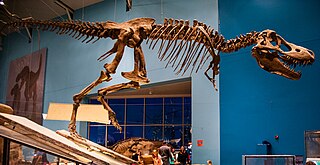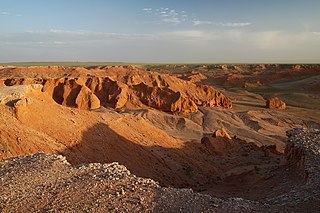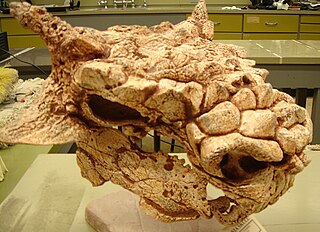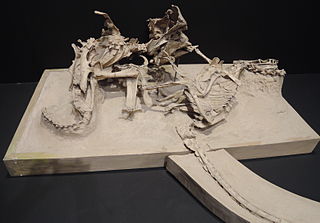
Velociraptor is a genus of small dromaeosaurid dinosaurs that lived in Asia during the Late Cretaceous epoch, about 75 million to 71 million years ago. Two species are currently recognized, although others have been assigned in the past. The type species is V. mongoliensis, named and described in 1924. Fossils of this species have been discovered in the Djadochta Formation, Mongolia. A second species, V. osmolskae, was named in 2008 for skull material from the Bayan Mandahu Formation, China.

Tarbosaurus is a genus of tyrannosaurine theropod dinosaur that lived in Asia about 70 million years ago, during the Maastrichtian age at the end of the Late Cretaceous period, considered to contain a single known species: Tarbosaurus bataar. Fossils have been recovered from the Nemegt Formation of Mongolia, with more fragmentary remains found further afield in the Subashi Formation of China.

Oviraptoridae is a group of bird-like, herbivorous and omnivorous maniraptoran dinosaurs. Oviraptorids are characterized by their toothless, parrot-like beaks and, in some cases, elaborate crests. They were generally small, measuring between one and two metres long in most cases, though some possible oviraptorids were enormous. Oviraptorids are currently known only from the Late Cretaceous of Asia, with the most well-known species and complete specimens found only in the Gobi Desert of Mongolia and northwestern China.

Shuvuuia is a genus of bird-like theropod dinosaur from the late Cretaceous period of Mongolia. It is a member of the family Alvarezsauridae, small coelurosaurian dinosaurs which are characterized by short but powerful forelimbs specialized for digging. The type species is Shuvuuia deserti, or "desert bird". The name Shuvuuia is derived from the Mongolian word shuvuu (шувуу) meaning "bird".

Protoceratops is a genus of small protoceratopsid dinosaurs that lived in Asia during the Late Cretaceous, around 75 to 71 million years ago. The genus Protoceratops includes two species: P. andrewsi and the larger P. hellenikorhinus. The former was described in 1923 with fossils from the Mongolian Djadokhta Formation, and the latter in 2001 with fossils from the Chinese Bayan Mandahu Formation. Protoceratops was initially believed to be an ancestor of ankylosaurians and larger ceratopsians, such as Triceratops and relatives, until the discoveries of other protoceratopsids. Populations of P. andrewsi may have evolved into Bagaceratops through anagenesis.

Deinocheirus is a genus of large ornithomimosaur that lived during the Late Cretaceous around 70 million years ago. In 1965, a pair of large arms, shoulder girdles, and a few other bones of a new dinosaur were first discovered in the Nemegt Formation of Mongolia. In 1970, this specimen became the holotype of the only species within the genus, Deinocheirus mirificus; the genus name is Greek for "horrible hand". No further remains were discovered for almost fifty years, and its nature remained a mystery. Two more complete specimens were described in 2014, which shed light on many aspects of the animal. Parts of these new specimens had been looted from Mongolia some years before, but were repatriated in 2014.

Avimimus, meaning "bird mimic", is a genus of oviraptorosaurian theropod dinosaur, named for its bird-like characteristics, that lived in the late Cretaceous in what is now Mongolia, around 85 to 70 million years ago.

Saurolophus is a genus of large hadrosaurid dinosaur from the Late Cretaceous period of Asia and North America, that lived in what is now the Horseshoe Canyon and Nemegt formations about 70 million to 66 million years ago. It is one of the few genera of dinosaurs known from multiple continents. The type species, S. osborni, was described by Barnum Brown in 1912 from Canadian fossils. A second valid species, S. angustirostris, is represented by numerous specimens from Mongolia, and was described by Anatoly Konstantinovich Rozhdestvensky.

Achillobator is a genus of large dromaeosaurid theropod dinosaur that lived during the Late Cretaceous period about 96 million to 89 million years ago in what is now the Bayan Shireh Formation of Mongolia. The genus is currently monotypic, only including the type species A. giganticus. The first remains were found in 1989 during a Mongolian-Russian field expedition and later described in 1999. Remains at the type locality of Achillobator may represent additional specimens. It represents the first and largest dromaeosaurid known from the Bayan Shireh Formation.

Nemegtosaurus was a sauropod dinosaur from the Late Cretaceous Period of what is now Mongolia. It was named after the Nemegt Basin in the Gobi Desert, where the remains — a single skull — were found. The skull resembles diplodocoids in being long and low, with pencil-shaped teeth. However, recent work has shown that Nemegtosaurus is in fact a titanosaur, closely related to animals such as Saltasaurus, Alamosaurus and Rapetosaurus.

Bagaceratops is a genus of small protoceratopsid dinosaurs that lived in Asia during the Late Cretaceous, around 72 to 71 million years ago. Bagaceratops remains have been reported from the Barun Goyot Formation and Bayan Mandahu Formation. One specimen may argue the possible presence of Bagaceratops in the Djadochta Formation.

Mononykus is a genus of alvarezsaurid dinosaur that lived during the Late Cretaceous in what is now Asia on the Nemegt Formation, about 70 million years ago.

Udanoceratops is a genus of large leptoceratopsid dinosaur that lived during the Late Cretaceous period of Mongolia, in what is now the Djadokhta Formation.

The Djadochta Formation is a highly fossiliferous geological formation situated in Central Asia, Gobi Desert, dating from the Late Cretaceous period, about 75 million to 71 million years ago. The type locality is the Bayn Dzak locality, famously known as the Flaming Cliffs. Reptile and mammal remains are among the fossils recovered from the formation.

Minotaurasaurus is a monospecific genus of ankylosaurid dinosaur that lived in Mongolia during the Late Cretaceous in what is now the Djadochta Formation. The type and only species, Minotaurasaurus ramachandrani, is known from two skulls, a cervical vertebra and a cervical half ring. It was named and described in 2009 by Clifford Miles and Clark Miles. The first fossils of Minotaurasaurus were illegally exported out of Mongolia.It has been suggested to be a synonym of Tarchia but more recent publications consider it as a distinct genus.

Ceratonykus is a monospecific genus of alvarezsaurid dinosaur from Mongolia that lived during the Late Cretaceous in what is now the Barun Goyot Formation. The type and only species, Ceratonykus oculatus, is known from a fragmentary skeleton, including an incomplete skull, of an adult individual. It was named and described in 2009 by Vladimir Alifanov and Rinchen Barsbold. Its describers questioned the traditional placement of alvarezsaurs in Theropoda, instead suggesting they were ornithischians, but this has not been accepted since. Ceratonykus has an estimated length of 75 centimetres and weight of 760 grams. It has been considered as a possible junior synonym of Parvicursor.

The Bayan Mandahu Formation is a geological unit of "redbeds" located near the village of Bayan Mandahu in Inner Mongolia and China and dates from the late Cretaceous Period. Laid down in the Campanian, it is dated somewhat uncertainly to between 75 and 71 mya.

The Fighting Dinosaurs is a fossil specimen which was found in the Late Cretaceous Djadokhta Formation of Mongolia in 1971. It preserves a Protoceratops andrewsi and Velociraptor mongoliensis trapped in combat about 80 million years ago and provides direct evidence of predatory behavior in non-avian dinosaurs. The specimen has caused much debate as to how both animals came to be preserved together with relative completeness. Several hypotheses have been proposed, including a drowning scenario, burial by either dune collapse or sandstorm, or alternatively they were not buried simultaneously.

Wulatelong is an extinct genus of basal oviraptorid dinosaur known from the Late Cretaceous Wulansuhai Formation of Bayan Mandahu, Linhe District of Inner Mongolia, northern China. It contains a single species, Wulatelong gobiensis.
Khulsanurus is an extinct genus of alvarezsaurid theropod dinosaur from the Late Cretaceous Barungoyot Formation of the Khulsan Locality in the Gobi Desert region of Mongolia. The type and only species is Khulsanurus magnificus.


















